Choosing the correct dumbbell weight is imperative for achieving effective training results as well as preventing wasted time and money due to buying the wrong dumbbells. This post explains how heavy dumbbells need to be considered light, medium, and heavy-weights.
Generally speaking, dumbbell weights up to 20lb are considered to be light, up to 50lb are considered to be medium, and up to 90lbs are considered to be heavy. However, the perceived weight of a dumbbell weight is also influenced by gender, age, body weight, and training history.
As a beginner, I was puzzled as to what each dumbbell weight classification meant.
The fastidious side of me NEEDED an exact quantifiable number for each weight category.
That’s why I created this post.
My research and experience will help you to choose the right dumbbell weight to reach your training goals and avoid wasting money on buying unsuitable dumbbells!
Let’s go.
Or if you’re interested, you can find out the different kinds of dumbbells here and which dumbbell type I think are the best here.
- Summary: Dumbbells Mentioned In This Post
- What Are Considered To Be Light, Medium, And Heavy Dumbbells?
- Why Perceived Dumbbell Weight Is Different For Everyone
- What Are Considered Light-Weight Dumbbells?
- What Are Considered Medium-Weight Dumbbells?
- What Are Considered Heavy-Weight Dumbbells?
- How To Choose Between Light/Medium/Heavy Dumbbells For Your Goals
- Dumbbell Recap
- Conclusion
Summary: Dumbbells Mentioned In This Post
| Dumbbell | Brand | Description | Prime | Buy |
|---|---|---|---|---|
 | Balance From | Light dumbbells. Adjustable to 20lbs each. Good for beginners to perform general fitness workouts at home. | PrimeEligible | Check Amazon Price |
 | Hola Hatha | BEST light dumbbell set. Sturdy and durable. Up to 15lbs each. Good for beginners to do light muscle-building and fat loss workouts at home. | Prime | Check Amazon Price |
 | Amazon Basics | Light dumbbells. Sold as single pairs. Good for beginners to do general fitness workouts. | PrimeEligible | Check Amazon Price |
Top Top
Top
Top
Top
Top Top
Top
Top
Top
Top | PowerBlock | BEST medium/heavy dumbbell. Base model starts at 50lbs. Fully adjustable up to 90lbs (using add-on kits) in 2.5lb increments. Great for all levels to build muscle and lose fat. | PrimeEligible | Check Amazon Price |
 Top
Top
Top
Top
Top Top
Top
Top
Top
Top | Bowflex | Medium dumbbell alternative. 50lbs adjustable. Features a traditional dumbbell shape and dial-a-weight adjustment mechanism. | PrimeEligible | Check Amazon Price |
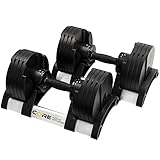 | Core Home Fitness | Medium dumbbell alternative. 50lbs adjustable. Features a traditional dumbbell shape and handle-turn weight adjustment mechanism. | PrimeEligible | Check Amazon Price |
 Top
Top
Top
Top
Top Top
Top
Top
Top
Top | Bowflex | Heavy dumbbell. Fully adjustable to 90lbs. Great for advanced muscle-building. | PrimeEligible | Check Amazon Price |
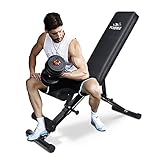 Top
Top | Flybird | Great value fully adjustable bench for your dumbbells. Can be set flat/incline/decline. Can also be folded and stowed away after a workout | PrimeEligible | Check Amazon Price |
What Are Considered To Be Light, Medium, And Heavy Dumbbells?
Below, you can see a table that gives the dumbbell weights that are considered to be light/medium/heavy for the average man and woman.
| Dumbbell Kg | Men | Women |
|---|---|---|
| 2-10lb (1-5kg) | Extremely Light | Very light |
| 15-20lb (6-10kg) | Very light | Light |
| 25-45lb (11-20kg) | Light | Medium |
| 45-65lb (21-30kg) | Medium | Heavy |
| 70-90lb (31-40kg) | Heavy | Very Heavy |
| 100lb+ (45kg+) | Very heavy | Extremely Heavy |
These classifications are based on my personal 10-year male training history.
This record has seen me progress from a beginner using light dumbbells, to an intermediate-advanced lifter using heavy dumbbells, for a variety of small isolation-type lifts and large compound-type lifts.
The classifications are also based on the finding that the average female has 33-40% strength compared to men.
Please note- these are highly generalized classifications of perceived dumbbell weight for the average person.
In reality, many different factors come together to determine what dumbbell weight you consider light, medium, or heavy (see next).
Why Perceived Dumbbell Weight Is Different For Everyone
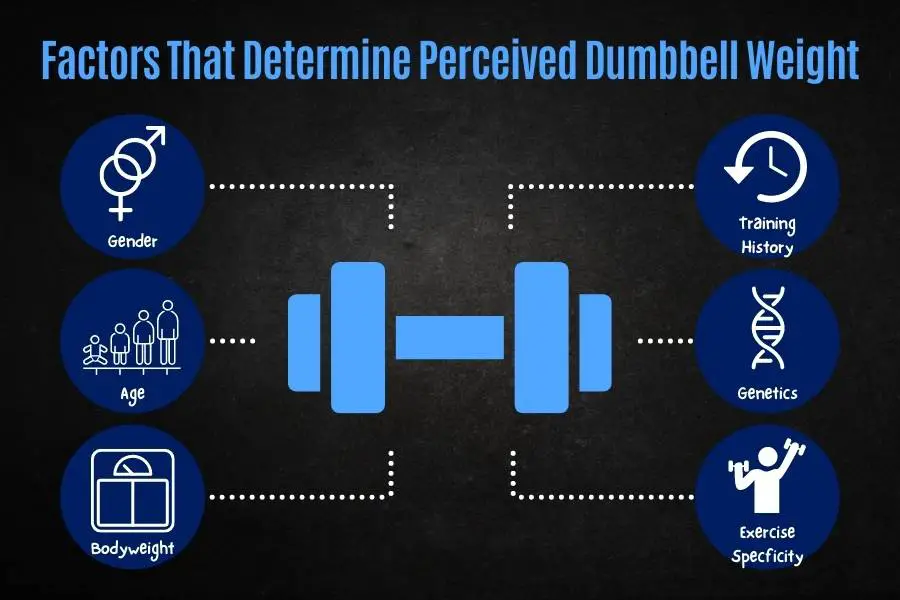
Here are the most common factors that affect how much dumbbell weight a person considers being light, medium, and heavy:
- Gender. Males have on average 26lbs more muscle mass comapred to women. Therefore a light dumbbell weight for a man may be considered medium for a woman.
- Age. Muscle mass generally peaks at around 25 years of age. Therefore a light dumbbell weight for a 25 year old may be considered to be heavy for a 40 year old.
- Bodyweight. Heavier people generally have more muscle mass. Therefore someone with a low bodyweight will likely consider a given dumbbell weight to be heavier than someone with a high bodyweight.
- Training history. Experienced lifters with a longer training history will be stronger for any given exercise. Therefore experienced lifters will deem a heavy dumbbell to be lighter, compared to a beginner.
- Genetics. People with a higher percentage fo fast-twitch muscle fibres generally have more strength compared to those who have mainly slow-witch fibres. These people will consider any given dumbbell weight to be lighter compared to those who have mainly slow-twicth fibres.
- Exercise specificity. Some exercises like the dumbbell curl work smaller muscles compared to other exercises like the squat which work large muscles. Therefore a heavy dumbbell weight for a bicep curl will feel considerably lighter on the dumbbell squat.
Together, these combined factors result in different people feeling the weight of their dumbbells differently.
That being said, the generalized classifications (see the previous table) serve as a good starting point to approximate how much dumbbell weight is considered light, medium, and heavy for you based on your gender.
If you are interested, you can check out my other article to find out how heavy dumbbells should be for bicep curls.
What Are Considered Light-Weight Dumbbells?
Generally speaking, light dumbbells are considered to weigh between 1 to 20lbs (0.5 to 10kg). However, women and people with low body weight or a short training history may find that these dumbbells feel heavier, compared to the men and those with high body weight or long training history.
The table below shows what you can generally do with light-weight dumbbells:
| Training Level | Build Muscle | Burn Fat | Tone | Get Ripped |
|---|---|---|---|---|
| Beginner men | Yes | Yes | Yes | No |
| Novice men | No | Yes | No | No |
| Intermediate men | No | Yes | No | No |
| Advanced men | No | Yes | No | No |
| Beginner women | Yes | Yes | Yes | No |
| Novice women | Yes | Yes | Yes | No |
| Intermediate women | No | Yes | No | No |
| Advanced women | No | Yes | No | No |
These dumbbells are most commonly used by male and female beginners who have 1 to 6 months of training experience. They are also popular with female novices who have 12-18 months of training experience.
What can light-weight dumbbells be used for?
Since light dumbbells do not offer much in terms of resistance, they won’t facilitate long-term progression or help you to achieve serious training goals (e.g. gaining significant amounts of muscle strength and size).
However, they can be great for light-weight fat-burning dumbbell HIIT (high-intensity interval training) workouts. If you’re struggling to lose weight, you can check out my dumbbell fat loss guide here.
Light dumbbells can also be used to build some upper body muscle using isolation-type exercises like the:
- Bicep curl to train the biceps (upper arm).
- Tricep extension to train the triceps (upper arm).
- Chest fly to train the pectorals (chest).
- Reverse fly to train the posterior deltoids (rear shoulder) and back.
- Lateral raise to train the medial deltoids (side shoulder).
- Front raise to train the anterior deltoids (front shoulder).
As an absolute beginner, light dumbbells may also be used to build a small amount of muscle from lower body exercises like the squat and lunge.
Just don’t be using these dumbbell weights and expect record-breaking gains!
These are generally no good for anyone at/past the intermediate stages of training.
If you are interested, you could also go to my other article to learn how to choose the ideal dumbbell weight for beginners.
Examples of light-weight dumbbells:
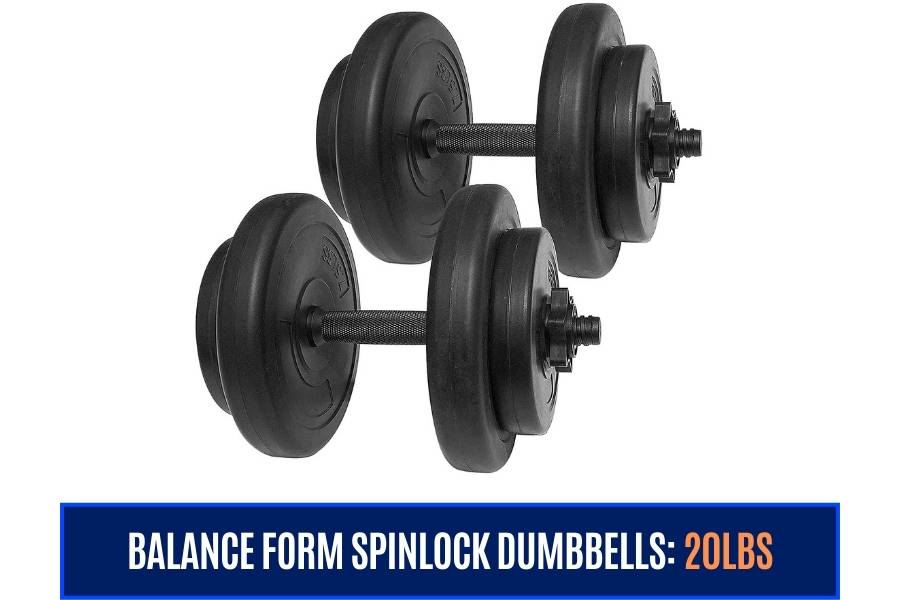
- Balance Form 20lb spinlock dumbbells. These are an extremely affordable set of dumbbells for beginners. They provide a variety of resistance levels from 5-20lbs (2-10kg). But the plastic-coated cement plates aren’t the most durable so I would recommend you to avoid dropping these.
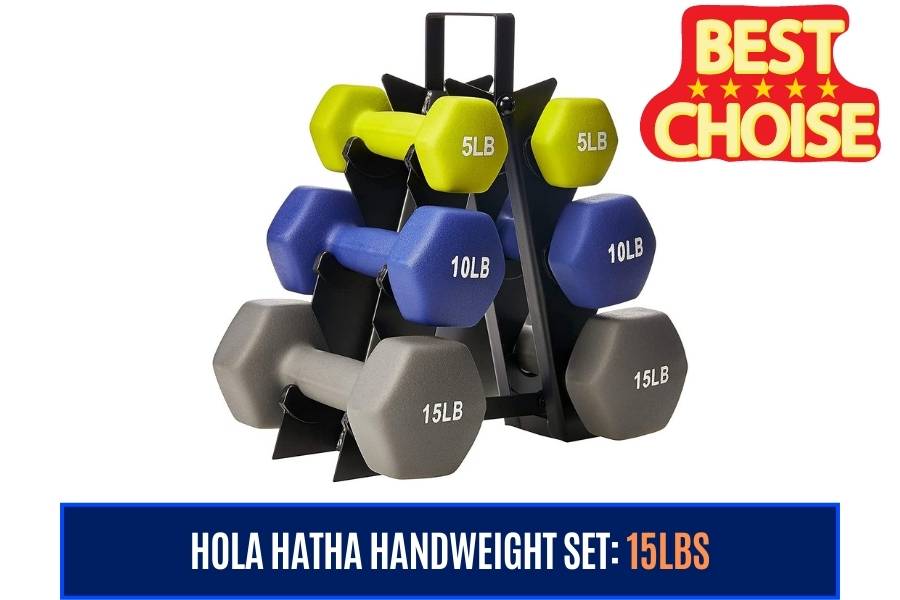
- Hola Hatha 15lb hand weight set (my choice). These are constructed from a solid one-piece neoprene-coated cast so they are much more durable than plastic-coated weights. They’re a bit more expensive than light spinlock dumbbells, but they are also much more durable. This set also comes with a mini rack for convenient storage.
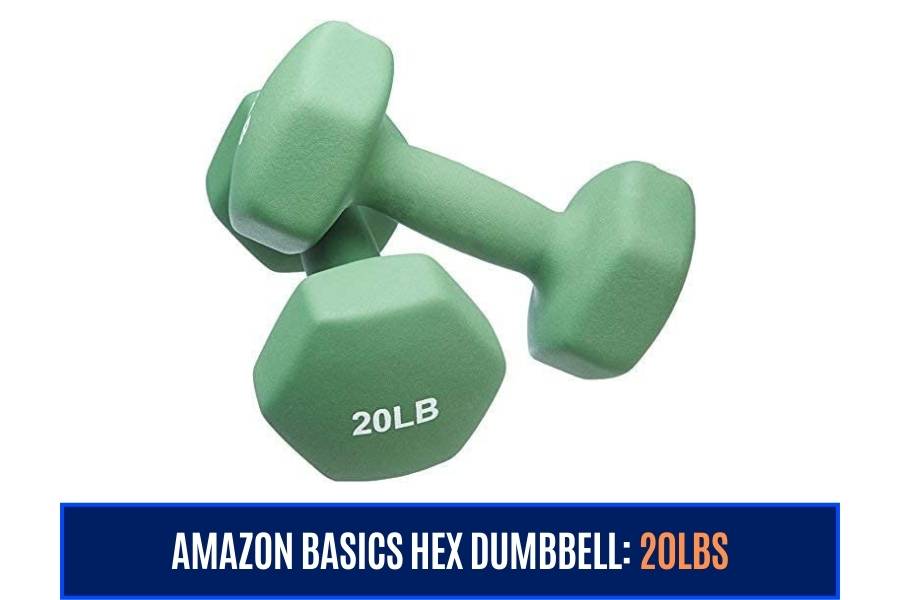
- Amazon basics 20lb hex dumbbell. This comes as a single pair of fixed-weight dumbbells. Just like the Hola Hatha’s, they are extremely durable. They’re also a bit cheaper. But you only get the two dumbbells (not a set). They can be used for general fitness and to casually train with the exercises detailed above.
You can click on the above links to check out each respective dumbbell’s full specs and cheapest price.
Alternatively, you might be interested in my other article to learn more about what 5kg/10lb dumbbells are and what you can do with them.
What Are Considered Medium-Weight Dumbbells?
Generally speaking, medium-sized dumbbells are considered to weigh between 25 to 50lbs (11 to 25kg). However, women and people with low body weight or a short training history may find that these dumbbells feel heavier, compared to the men and those with high body weight or long training history.
The table below shows what you can generally do with medium-weight dumbbells:
| Training Level | Build Muscle | Burn Fat | Tone | Get Ripped |
|---|---|---|---|---|
| Beginner men | Yes | Yes | Yes | Yes |
| Novice men | Yes | Yes | Yes | Yes |
| Intermediate men | No | Yes | No | No |
| Advanced men | No | Yes | No | No |
| Beginner women | Yes | Yes | Yes | Yes |
| Novice women | Yes | Yes | Yes | Yes |
| Intermediate women | Yes | Yes | Yes | Yes |
| Advanced women | No | Yes | No | No |
These dumbbells are most commonly used by male novices who have 12-18 months of training experience, or female intermediates who have 24 to 48 months of training experience.
If you’re interested, you can check out my other post to find out my dumbbell recommendations for men here!
What can medium-weight dumbbells be used for?
Medium dumbbells are one of the most popular weight choices because they offer a good balance between functionality and affordability.
At 25 to 50lbs resistance per dumbbell, you can effectively perform a variety of exercises for different training goals.
The average man can build muscle to a novice level, whilst women can do the same to an intermediate level.
This is enough to gain an estimated 10 to 15lbs+ of muscle at home.
Good exercises to perform using medium-weight dumbbells include the same isolation-type exercises you can perform with light dumbbells (see previous).
But at these resistance levels, medium-sized dumbbells are also great for muscle-building compound moves such as the:
- Bench press to train the pectorals, triceps, and anterior delotids (chest, arms, and front shoulder),
- Shoulder press to train all 3 deltoids (shoulders).
- Row to train all the back muscles.
- Squat to train all the leg muscles.
- Deadlfit to train the entire body.
You can also use medium-weight dumbbells for fat-burning HIIT workouts, develop overall muscle tone, and increase muscle definition.
These are a great dumbbell weight for beginners to make muscle size, strength, and physique gains for a good 2 years and take them into the intermediate stages of training (and often even further).
Ideally, your medium-sized dumbbells should be fully adjustable to allow you to switch between light and medium weights for different exercises.
You can see my other post to find out how beginners use 10kg/20lb dumbbells to build muscle.
Examples of medium-weight dumbbells:
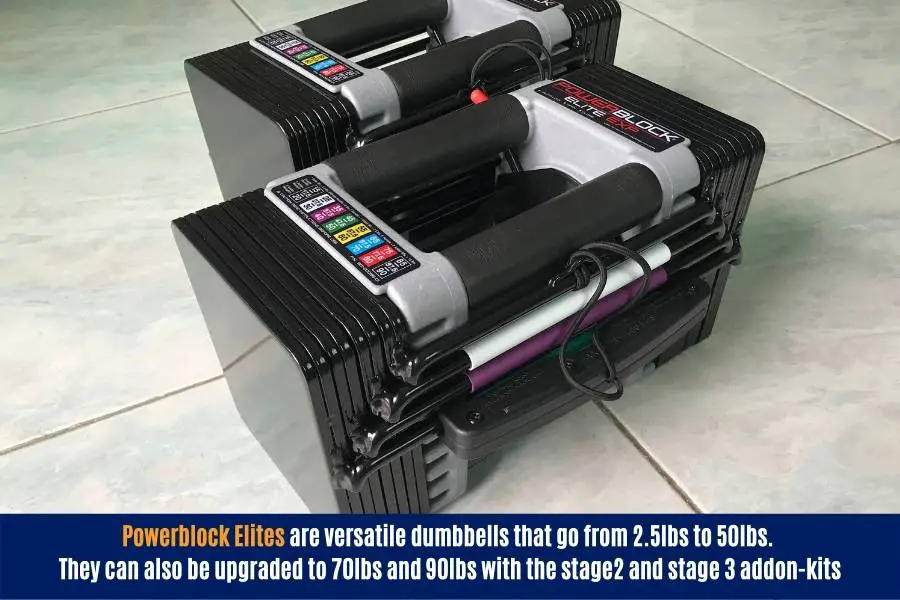
- Powerblock Elite 50 (my choice). These are the ones I use and recommend. The base model weighs 50lbs, it’s fully adjustable, and they’re the cheapest of all the premium-brand dumbbells. The heavier poundages are great for compound lifts whilst the lower poundages are ideal for the isolation-type movements and HIIT workouts. They also feature 2.5lb increments. These small weight increments are perfect for smooth strength progression. You can find my full test review here.
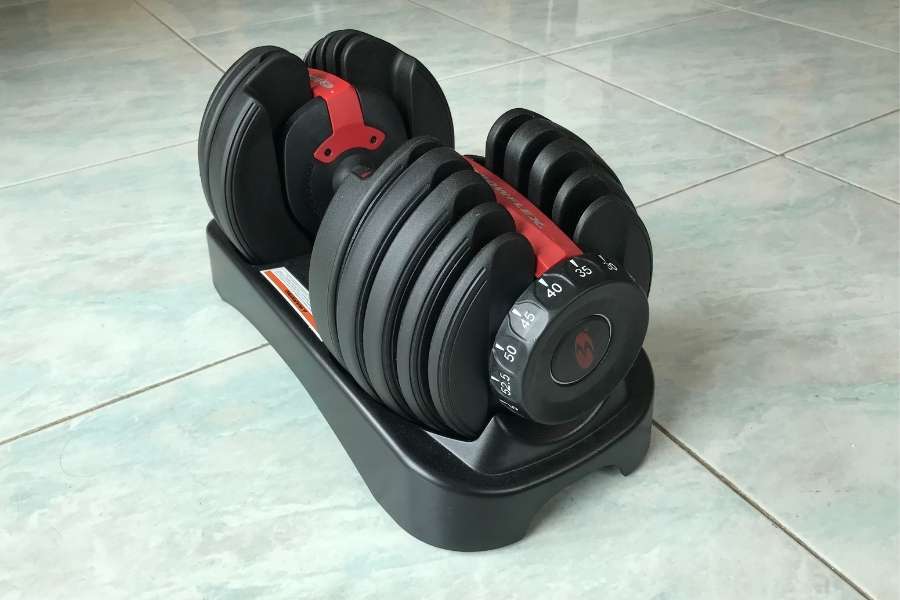
- Bowflex Selectech 552i. These share very similar perks to the Powerblock Elites (they are their direct competitor). Having used both, I found that the Bowflex dial-adjustment mechanism doesn’t feel half as durable as the Poweblock pin-selector. Additionally, the Bowflex warranty only lasts for 2 years, compared to the Powerblock’s 5-years. Some people prefer the Bowflex’s more traditional-looking dumbbell shape though. You can find details of my full user-test of this dumbbell here.
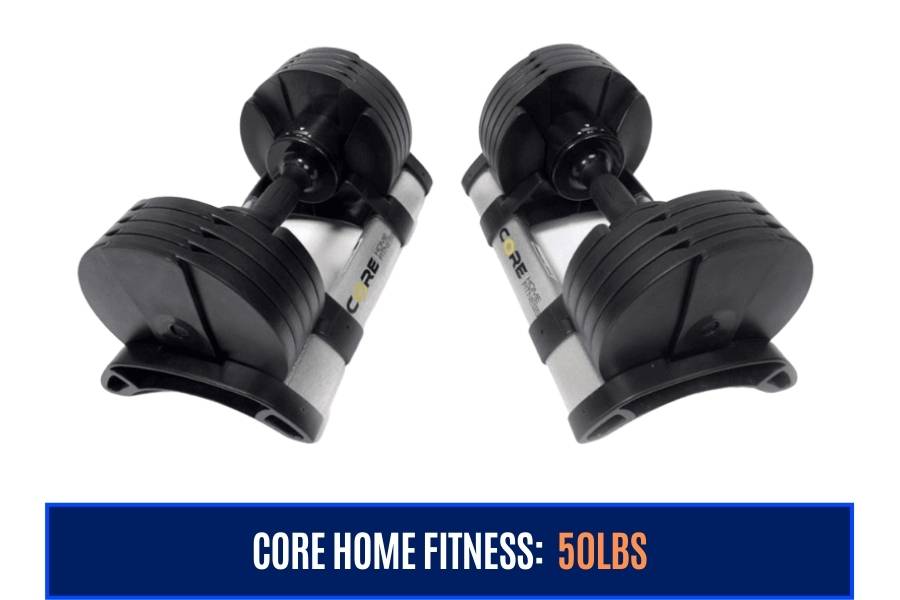
- Core Home Fitness. These are medium-weight dumbbells from a reputable mid-range brand. They weigh 50lbs per dumbbell and fully adjustable with 5lb increments. They are significantly cheaper compared to the Powerblock and Bowflex. But they don’t feature the much desired 2.5lb increments.
You can click on the above links to check out each respective dumbbell’s full specs and cheapest price.
For more information on choosing the right dumbbell weight, you may be interested in my other post to learn more about the ideal dumbbell kg for your training level.
What Are Considered Heavy-Weight Dumbbells?
Generally speaking, heavy dumbbells are considered to weigh between 70 to over 90lbs (30 to over 40kg). These are the heaviest dumbbells on the consumer market. Both the average man and woman will likely find these dumbbells to be extremely challenging to lift.
The table below shows what you can generally do with heavy-weight dumbbells:
| Training Level | Build Muscle | Burn Fat | Tone | Get Ripped |
|---|---|---|---|---|
| Beginner men | Yes | Yes | Yes | Yes |
| Novice men | Yes | Yes | Yes | Yes |
| Intermediate men | Yes | Yes | Yes | Yes |
| Advanced men | Yes | Yes | Yes | Yes |
| Beginner women | Yes | Yes | Yes | Yes |
| Novice women | Yes | Yes | Yes | Yes |
| Intermediate women | Yes | Yes | Yes | Yes |
| Advanced women | Yes | Yes | Yes | Yes |
These dumbbells are most commonly used by intermediate to advanced lifters who have 2 to 5+ years of training experience. They are also popular with beginners who have long-term goals to reach these stages of training.
If you’re a beginner with ambitious goals in mind, it’s worth spending a bit extra on heavy dumbbells from the get-go. It means you don’t have to waste time and money on replacing dumbbells you outgrow.
Buying heavy dumbbells doesn’t have to break the bank either.
I have two dumbbell recommendations (see below) that allow you to purchase additional weight in the form of addon kits. This means you can upgrade the weight increments (as you become stronger), rather than making a one-off big lump sum of cash.
What can heavy-weight dumbbells be used for?
The main reason why people buy heavy dumbbells is to build muscle, strength, and tone.
They are ideal for performing the heavy compound lifts at home (bench press, shoulder press, row, squat, deadlift, and their variations).
This makes them great for people with long-term goals of building a powerful and ripped-looking physique.
If this isn’t something that appeals to you, then medium-weight dumbbells will likely do the job perfectly fine.
If you buy a good pair of heavy adjustable dumbbells that also feature lighter poundages, then they can also be used for cardio, HIIT, and fat-burning workouts too.
As you can see, these dumbbells allow most people to achieve all training goals. But obviously, you should consider if the price is worth paying for the benefits they provide.
These are great dumbbells to last beginners a good 5+ years of muscle gains to take them to the advanced stages of training. They’ll also last intermediates a good 3+ years of muscle gains to take them into the advanced stages of training.
You may be interested in my other article to find out about the best dumbbell bodybuilding exercises.
Examples of heavy-weight dumbbells:

- Powerblock Elite 90 (my choice). These are the same as the medium-weight Powerblock Elites (described previously), but with the addon-kits applied. The kits are retro-fitted, meaning they can be installed onto the base model whenever you wish (they don’t need to all be purchased in one go). These kits take the Powerblocks to 70 and 90lbs. These are some of the best value 90lb dumbbells you can buy!
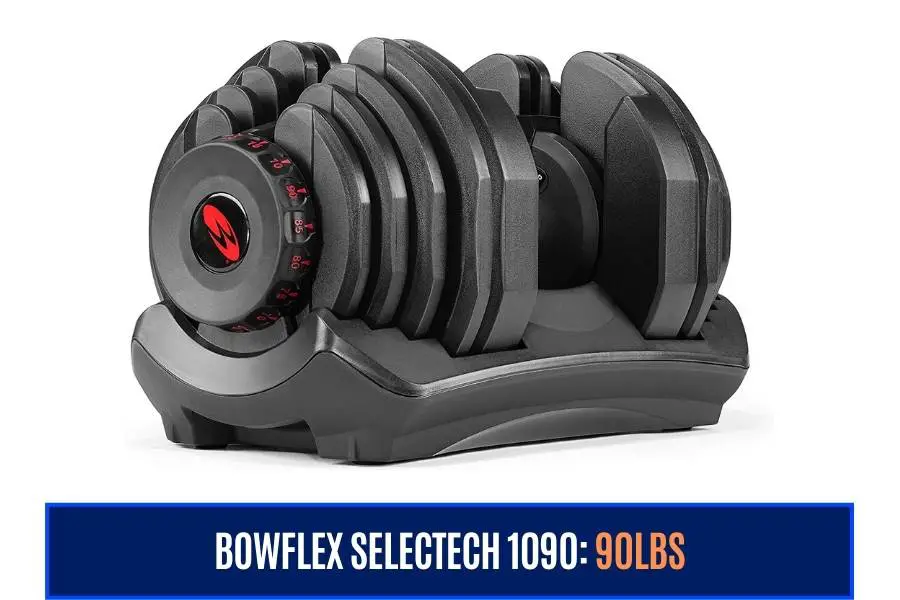
- Bowflex 1090. This is Bowflex’s competing model to the Powerblock Elite 90. I’ve tested these, and they feel pretty darn solid. But I chose the Powerblocks in the end because of their aforementioned upgrade flexibility. Although Bowflex offers 90lbs per dumbbell, you need to pay for them in one transaction (unlike the Powerblocks). And these things aren’t exactly cheap either.
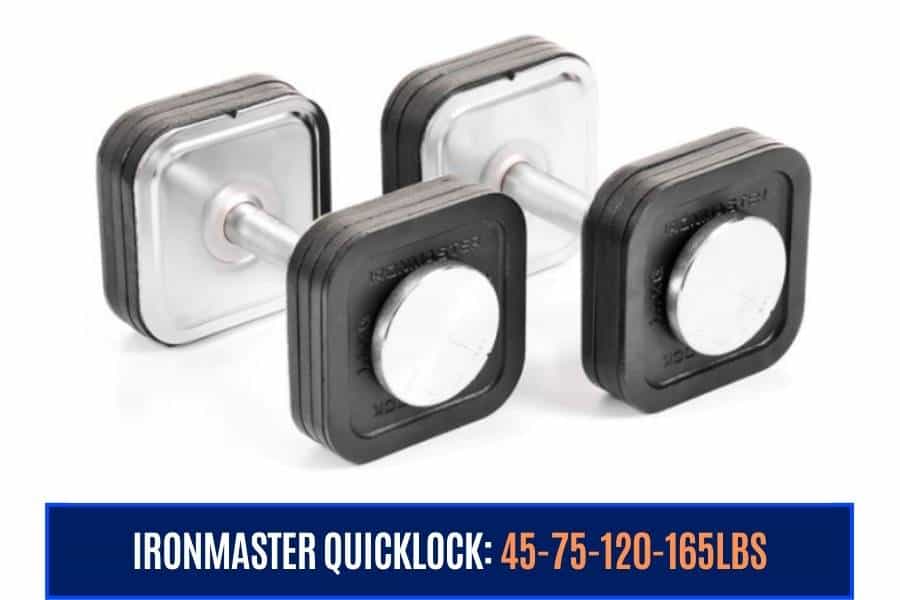
- Ironmaster quicklock 120. These are the Rolls-Royce of the heavy-dumbbells. The base mdoel weighs 45lbs and are quite expensive for the weight you get. But they can be upgraded (like the Powerblocks) to a gargunatan 75, 120, and 165lbs. These are also known to be the most durable adjustable dumbbells out there. The drawback? Their hefty price tag!
You can click on the above links to check out each respective dumbbell’s full specs and cheapest price.
How To Choose Between Light/Medium/Heavy Dumbbells For Your Goals
The ideal dumbbell weight allows a person to reach their long-term goals. Those who are looking to maximize muscle size and strength gains should choose medium or heavy dumbbells. Those who are looking to burn fat or train for general fitness can use lighter dumbbells.
As you know- different resistance levels are required to reach different goals. These are as follows:
| Training Goal | Number Of Reps Per Set | Rest Time Between Sets | Recommended Weight |
|---|---|---|---|
| Increase strength | 4-6 | 4-5 minutes | 85-90% of 1 rep max |
| Build muscle size and tone | 8-15 | 1-3 minutes | 50-80% of 1 rep max |
| Fat-burning | 8-15 | 30-60 seconds | 50-80% of 1 rep max |
| Cardio | 8-25 | 30-60 seconds | 10-80% of 1 rep max |
How do you apply the data in the table above? In other words, how do you choose your ideal dumbbell weight?
Here’s how:
- Establish your training goal.
- Determine the exercises you’ll likely perform to reach your goal.
- Calculate how much weight you need for these exercises by taking x% of your 1RM for that exercise (as per table above).
This allows you to approximate how much weight you’ll require from your dumbbells to perform your chosen exercises.
But please don’t forget to factor in some redundant weight to account for future progression (e.g. if you think you require 50lb dumbbells, then it’s not a bad idea to get 70lbs for future-proofing).
Finally- you can use the comprehensive Strength Levels database to estimate your 1RM. Simply use your gender, body weight, and training level to estimate your 1RM based on what similar people have lifted. It contains data for all the major dumbbell exercises.
If you’ve already got dumbbells and are not sure if they’re the right weight, you may want to check out my other article for signs that your dumbbells are too heavy or light.
Dumbbell Recap
| Dumbbell | Brand | Description | Prime | Buy |
|---|---|---|---|---|
 | Balance From | Light dumbbells. Adjustable to 20lbs each. Good for beginners to perform general fitness workouts at home. | PrimeEligible | Check Amazon Price |
 | Hola Hatha | BEST light dumbbell set. Sturdy and durable. Up to 15lbs each. Good for beginners to do light muscle-building and fat loss workouts at home. | Prime | Check Amazon Price |
 | Amazon Basics | Light dumbbells. Sold as single pairs. Good for beginners to do general fitness workouts. | PrimeEligible | Check Amazon Price |
Top Top
Top
Top
Top
Top Top
Top
Top
Top
Top | PowerBlock | BEST medium/heavy dumbbell. Base model starts at 50lbs. Fully adjustable up to 90lbs (using add-on kits) in 2.5lb increments. Great for all levels to build muscle and lose fat. | PrimeEligible | Check Amazon Price |
 Top
Top
Top
Top
Top Top
Top
Top
Top
Top | Bowflex | Medium dumbbell alternative. 50lbs adjustable. Features a traditional dumbbell shape and dial-a-weight adjustment mechanism. | PrimeEligible | Check Amazon Price |
 | Core Home Fitness | Medium dumbbell alternative. 50lbs adjustable. Features a traditional dumbbell shape and handle-turn weight adjustment mechanism. | PrimeEligible | Check Amazon Price |
 Top
Top
Top
Top
Top Top
Top
Top
Top
Top | Bowflex | Heavy dumbbell. Fully adjustable to 90lbs. Great for advanced muscle-building. | PrimeEligible | Check Amazon Price |
 Top
Top | Flybird | Great value fully adjustable bench for your dumbbells. Can be set flat/incline/decline. Can also be folded and stowed away after a workout | PrimeEligible | Check Amazon Price |
Conclusion
I’ve explained the exact dumbbell weights that are considered to be light, medium, and heavy.
Whilst the perceived weight of a dumbbell is highly personal for different people, the generalized classifications I give you serve as a good starting point to choose the ideal weight to reach your training goals.
If you’re training to build maximum muscle- aim for heavy dumbbells that weigh 70-90lbs (30-40kg).
If you’re training for fat loss and general fitness- lighter dumbbells weighing 1-20lbs (0.5-10kg) will suffice.
And if you’re somewhere in between- medium dumbbells weighing 25-50lbs (11-25kg) are great.
What dumbbell weight will you be using?
Let me know in the comments!
You may also be interested in the downloadable Kalibre Blueprint PDF which details exactly how I gained 40lbs of lean muscle (it’s 100% free!). It details the exact exercises and nutrition I used to go from skinny to ripped!
Thanks for reading guys!
Peace Out,
Kal
(Biochemistry BSc, Biomedical Sciences MSc, Ex-Skinny Guy)


